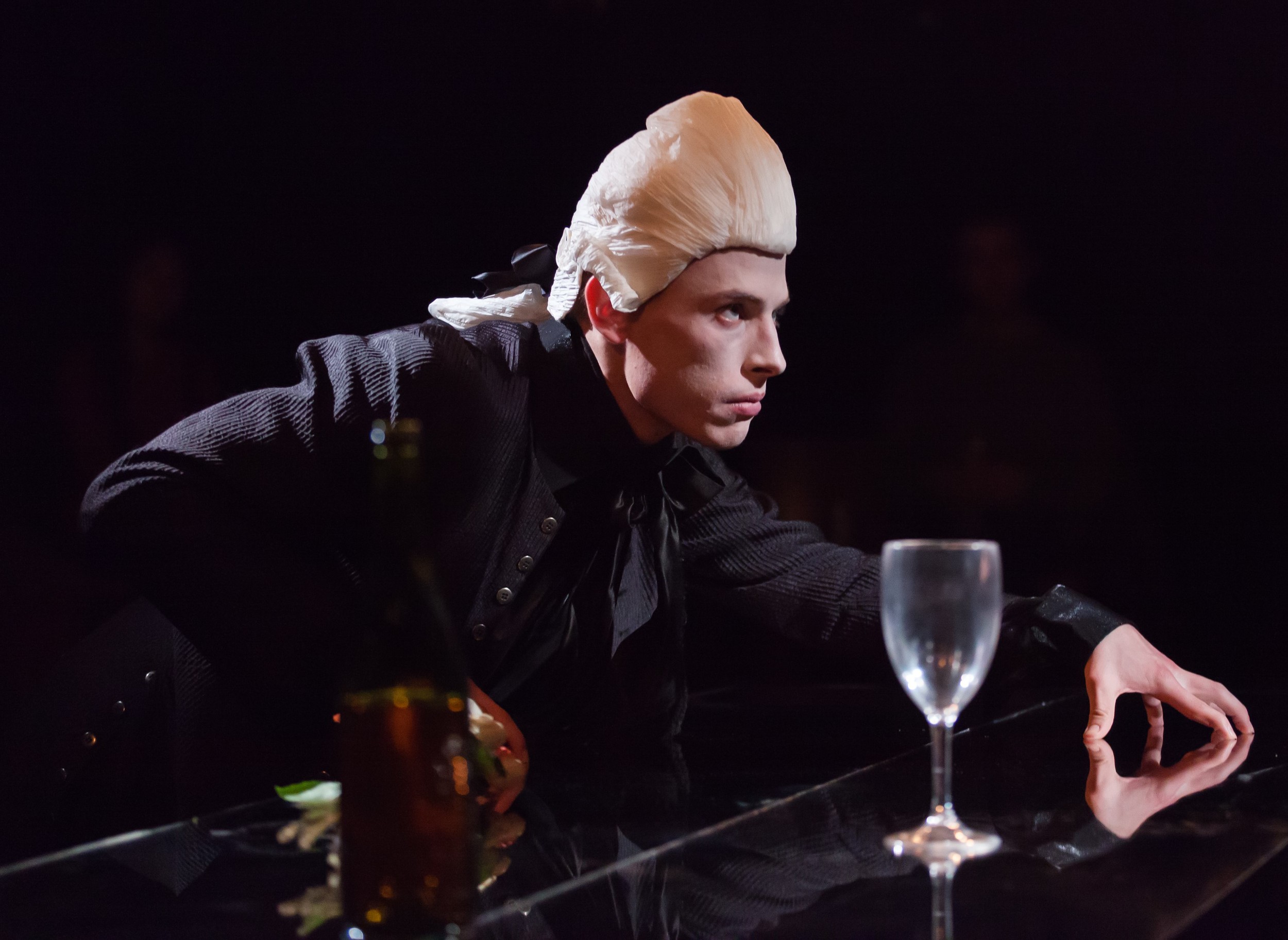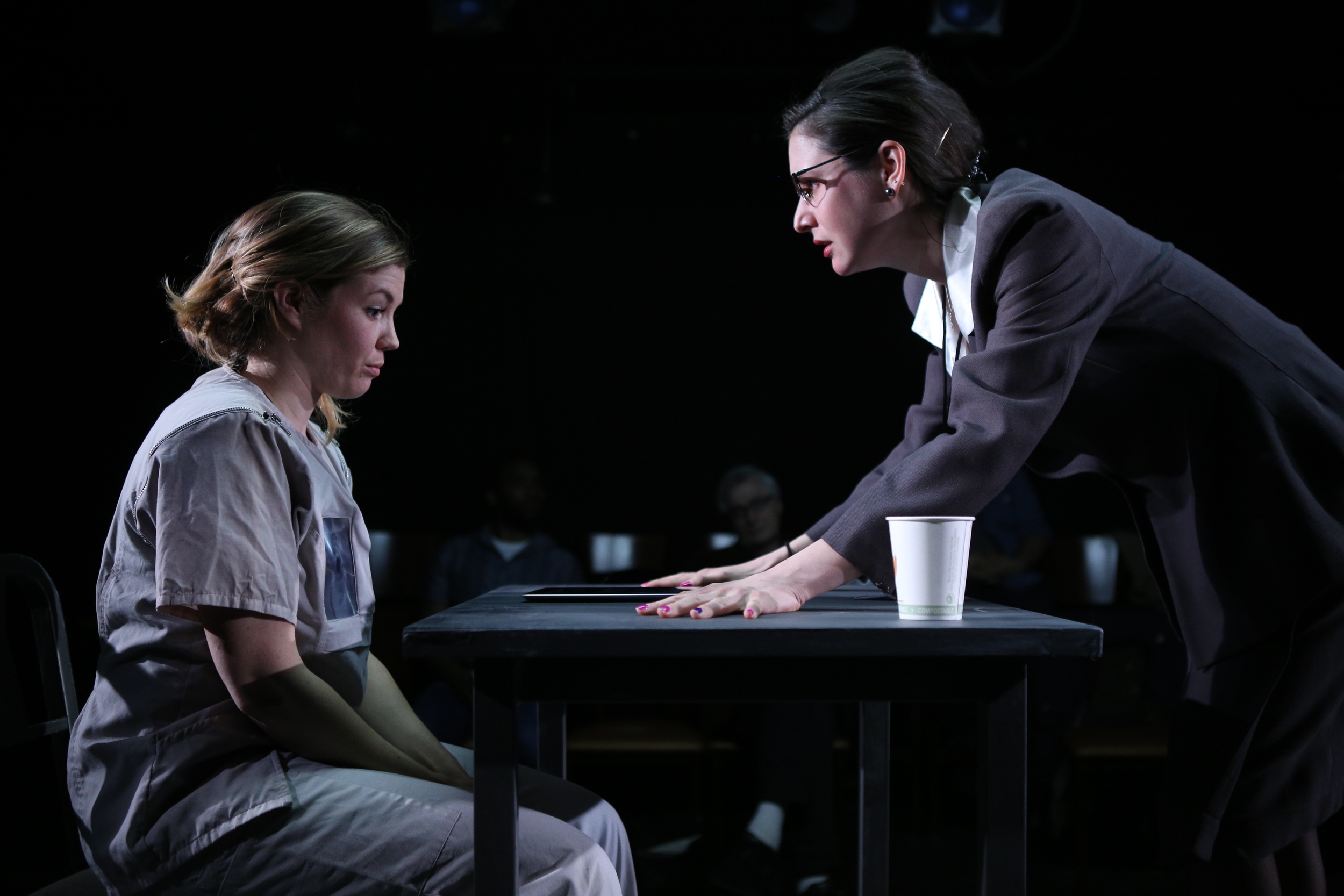Review of Man of La Mancha, Westport Country Playhouse
A revival of a popular crowd-pleaser has to make you wonder: is it to have on the schedule something everyone knows and loves, or is it to make a difference with a well-known war horse? The Westport Country Playhouse’s Man of La Mancha, directed by Mark Lamos, is having it both ways. It’s packing them in, as the saying goes, but it’s also spinning the show with an eye to our times.
Take that opening. Sure, the show always begins with Miguel de Cervantes (Philip Hernandez), the author of Don Quixote de la Mancha, arriving at a prison that houses those who have run afoul of the agents of the Inquisition. That historical fact of Christianity, once persecuted and oppressed, become persecutor and oppressor is key to the setting, the background to Cervantes’ flights of fancy and the madness of his knight-errant. Here, Cervantes is escorted by officers who look like they work for ICE. And those bars at the edge of the stage remain in place until the dramatic shift into Cervantes’ tale. When the bars return, if they don’t make you think of a concentration camp and those cages for the children of immigrants, then you must be as great a fantasist as Don Alonso Quixano, the man whose imagination creates the world of Don Quixote.
Don Quixote (Philip Hernandez) and the cast of Westport Country Playhouse’s production of Man of La Mancha (photos by Carol Rosegg)
The story, following Quixote’s adventures, tends to be tongue-in-cheek, as those he encounters know he’s mad, but find a certain amusement in humoring him. None sets that tone better than Michael Mendez, who plays the Innkeeper who is willing to dub Quixote a knight. Others, such as Aldonza (Gisela Adisa), a prostitute and serving girl, find playing along too strange, at least at first. Meanwhile, Quixano’s sister Antonia (Paola Hernandez) and his housekeeper (Lulu Picart) want him to come to his senses before something bad happens to his fortune—as they make clear in the witty number “We’re Only Thinking of Him.”
Housekeeper (Lulu Picart), Padre (Carlos Encinas), Antonia (Paola Hernandez)
Gauging the point at which cynicism enters into the indulgence of Quixano/Quixote has always been part of the paradoxical story: we know Quixote’s vision is foolish but we indulge it because it’s more interesting than reality. But, here, when Quixote thunders that “facts get in the way of the truth” and nods at the audience’s reaction, we can begin to wonder why we are so willing to indulge a fantasist who believes that a gold-colored shaving dish is a helmet of real gold or that a prostitute is an elegant lady. In other words, this version of Man of La Mancha gets closer to Cervantes’ novel than, I expect, many a production of the musical ever has. And that aligns it well with our time in which—call it what you like—a sow’s ear remains a sow’s ear.
Don Quixote (Philip Hernandez)
Granted, when the show won all those Tonys back in 1965, “The Impossible Dream,”—the show-stopping song that became ubiquitous in that period—might give backbone to a “glorious quest” to “march into hell” for the “heavenly cause” of stopping the spread of communism in southeast Asia. Once one entertains that notion, it’s easy to see how vainglorious are Don Quixote’s noble dreams.
And if that point needs more punch, there’s the rape of Aldonza by a pack of muleteers that Quixote and his friends—Aldonza and the ever-loyal Sancho Panza (Tony Manna)—had earlier dispatched in quite a busy fight scene (Michael Rossmy, fight director and intimacy coach). Quixote, foolishly, lets Aldonza “minister” to his fallen enemies. The rape, which Lamos handles as tastefully as one can, becomes uncomfortable sooner in the #MeToo era, particularly after the unsavory accusations that have been leveled at the most recent Republican Supreme Court nominee. To watch the scene was always to think about what it says about the nature of the reality Aldonza lives (despite Quixote’s romantic fantasy), but now it must make one think about the reality that even well-born and educated and successful women face, in all walks of life.
Certainly, when this show was decided on to fill this slot in Westport’s season, no one could know that Brett Kavanagh would be in the hotseat as the show opened, but it’s where we are now. Made all the more telling by that huge mirrored shield enacting Hamlet’s idea of the purpose of playing.
Aldonza (Gisela Adisa) and the cast of Westport Country Playhouse’s production of Man of La Mancha
As far as crowd-pleasing aspects of the show: start with the evocative stage design by Wilson Chin, which broods enough for a prison but has elements of sanctity as well, with that cathedral-like clerestory. Fabian Fidel Aguilar’s costumes are sumptuous when needed—such as the cape and armor of Quixote’s get-up or the threads that drape Antonia—and feature a range of homespun ensembles, and on Lulu Picart exciting color combos. As Aldonza, Gisela Adisa is perfectly outfitted, and she’s a tour de force of reactions and glances aside. Her movement and singing put much of the fire into the show, with “What Does He Want of Me” a high point in Act 1.
As our hero—a chastened Cervantes, a doddering Quixano, and, especially, a fully assertive Quixote—Philip Hernandez is perfect. He looks the part, tall and a little craggy, and he gives “The Impossible Dream” all the gusto it requires, letting the audience exult in its inspiring uplift. He’s abetted by Tony Manna’s Sancho, who shines best when we can see the wily peasant only too eager to serve whatever pays. He’s a little flat at times, not quite the colorful bon vivant one expects.
Sancho Panza (Tony Manna), Don Quixote (Philip Hernandez), Aldonza (Gisela Adisa)
The rest of the cast play a number of roles, as prisoners and as the persons in Quixote’s story. Particular mention goes to Esteban Suero’s great turn as the Barber (I wanted more of him!), Mendez’s canny Innkeeper, and Ceasar F. Barajas (Pedro) and Ian Paget (Anselmo), the prisoners/muleteers who lead “Little Bird,” and much of the action, which is eye-catching and well-choreographed throughout.
In the end, the “impossible dream” is likely what it always was: a glimmer of hope for those who are trying to make a sad reality better and more bearable. And while Mark Lamos’ Man of La Mancha perhaps needs a little more stirring to become the wonderful dish it could be, all the ingredients are there. And that’s no fantasy.
Man of La Mancha
Written by Dale Wasserman
Music by Mitch Leigh, Lyrics by Joe Darion
Directed by Mark Lamos
Scenic Design: Wilson Chin; Costume Design: Fabian Fidel Aguilar; Lighting Design: Alan C. Edwards; Sound Design: Domonic Sack; Musical Staging: Marcos Santana & Mark Lamos; Choreographer: Marcos Santana; Music Director: Andrew David Sotomayor; Music Supervisor: Wayne Baker; Fight Director/Intimacy Coach: Michael Rossmy; Props Master: Samantha Shoffner; Production Stage Manager: Ryan Gohsman
Cast: Gisela Adisa, Ceasar F. Barajas, Carlos Encinias, Michael Scott Gomez, Philip Hernandez, Paola Hernandez, Tony Manna, Michael Mendez, Ian Paget, Lulu Picart, Jermaine Rowe, David Sattler, Clay Singer, Esteban Suero
Musicians: Ben Clymer, trombone; Nicholas DiFabbio, guitar; Daniel Louis Duncan, trumpet; Simon Hutchings, reeds; Joseph Russo, string bass; Marshall Sealy, French horn; Arei Sekiguchi, percussion
Westport Country Playhouse
September 25-October 13, 2018
















